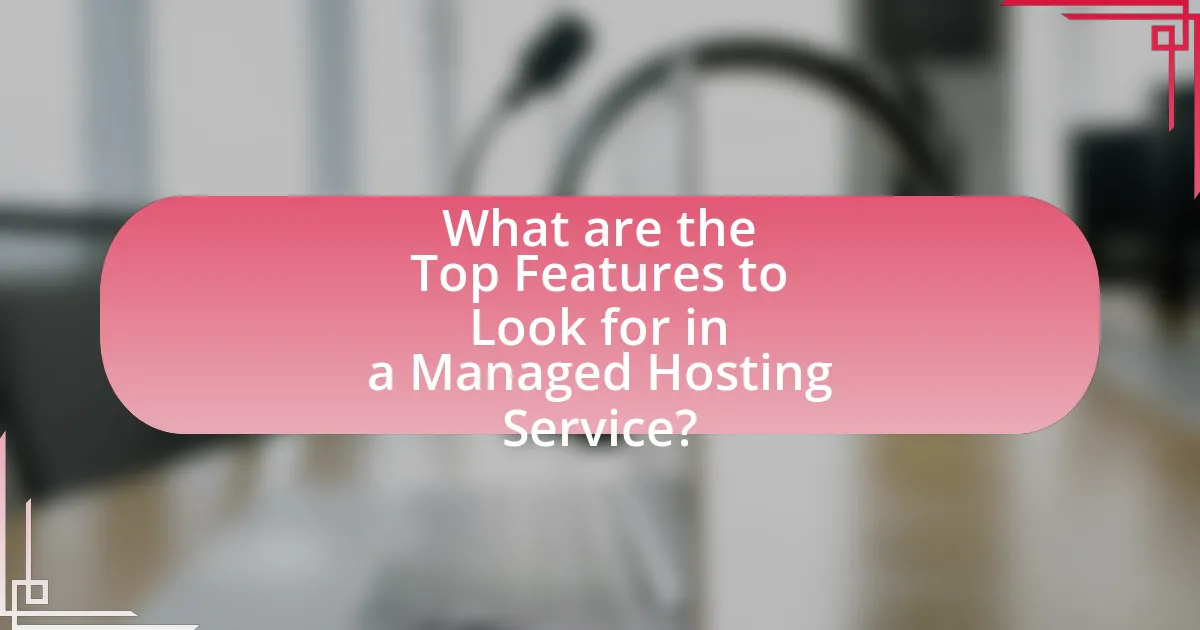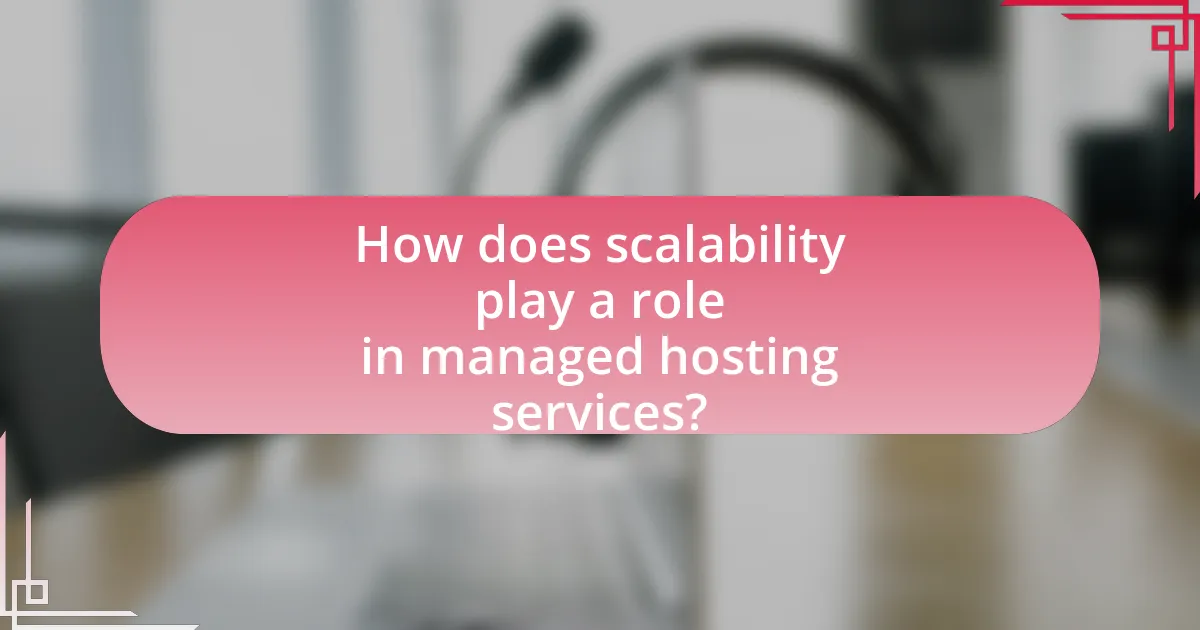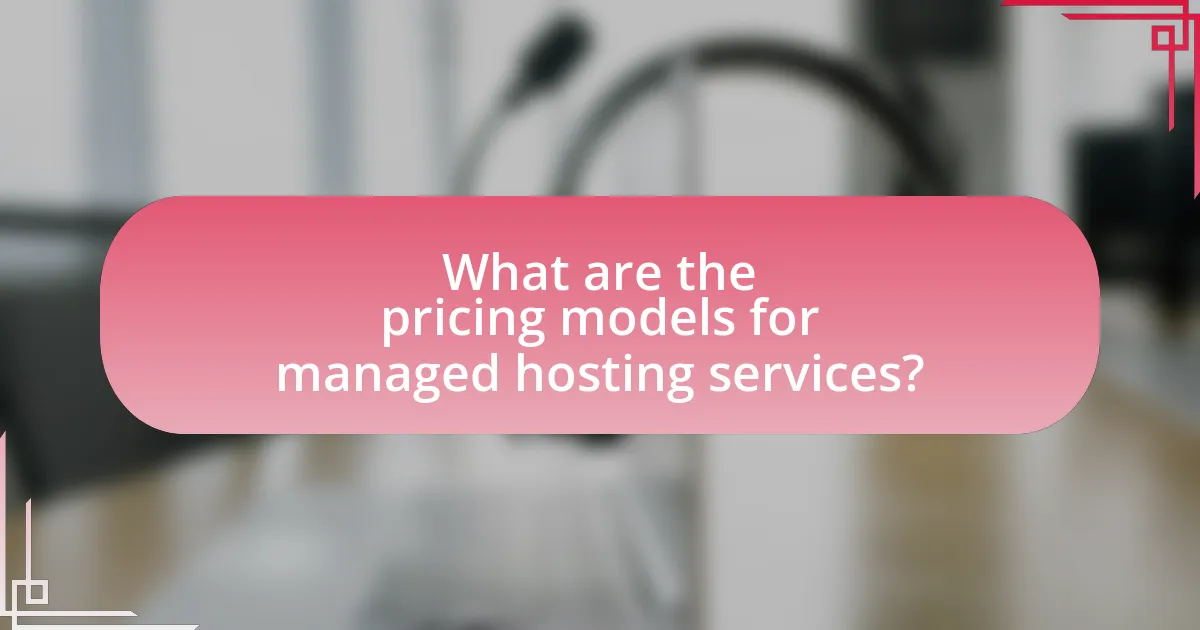The article focuses on the essential features to consider when selecting a managed hosting service. Key aspects include robust security measures, reliable uptime guarantees, comprehensive customer support, scalability options, and automated backups. It discusses how these features impact performance, the importance of specific performance metrics such as uptime and response time, and the variations in service offerings among different providers. Additionally, the article emphasizes the significance of customer support, security features, and compliance standards, while also addressing pricing models and best practices for evaluating potential providers.

What are the Top Features to Look for in a Managed Hosting Service?
The top features to look for in a managed hosting service include robust security measures, reliable uptime guarantees, comprehensive customer support, scalability options, and automated backups. Robust security measures, such as firewalls and DDoS protection, are essential to safeguard data. Reliable uptime guarantees, typically above 99.9%, ensure that websites remain accessible. Comprehensive customer support, available 24/7, is crucial for resolving issues promptly. Scalability options allow businesses to adjust resources as needed, accommodating growth. Automated backups provide peace of mind by ensuring data recovery in case of failures. These features collectively enhance the performance and reliability of managed hosting services.
How do these features impact the performance of a managed hosting service?
The features of a managed hosting service significantly enhance its performance by providing optimized resources, expert management, and robust security. Optimized resources, such as dedicated servers and scalable bandwidth, ensure that websites can handle high traffic volumes without slowdowns. Expert management, including 24/7 technical support and proactive monitoring, minimizes downtime and resolves issues quickly, which is crucial for maintaining service reliability. Additionally, robust security features, such as firewalls and regular backups, protect against data breaches and loss, further ensuring consistent performance. These elements collectively contribute to a more efficient, reliable, and secure hosting environment, which is essential for businesses that rely on their online presence.
What specific performance metrics should be considered?
Specific performance metrics to consider in a managed hosting service include uptime, response time, load time, and resource utilization. Uptime measures the percentage of time the service is operational, with a standard target being 99.9% or higher, indicating reliability. Response time assesses how quickly the server responds to requests, ideally under 200 milliseconds for optimal user experience. Load time refers to the duration it takes for a webpage to fully render, with best practices suggesting under 3 seconds to minimize bounce rates. Resource utilization tracks the efficiency of CPU, memory, and bandwidth usage, ensuring that the hosting service can handle traffic spikes without degradation in performance. These metrics are critical for evaluating the overall effectiveness and reliability of a managed hosting service.
How do these metrics vary across different hosting providers?
Metrics such as uptime, speed, customer support response time, and scalability vary significantly across different hosting providers. For instance, some providers like SiteGround boast an uptime of 99.99%, while others may offer lower percentages, affecting website reliability. Speed can also differ, with providers like A2 Hosting claiming page load times as low as 2.9 seconds, compared to others that may take longer. Customer support response times can range from immediate assistance with providers like Bluehost to longer wait times with others, impacting user experience. Scalability options also differ, with some providers offering seamless upgrades while others may require more complex migrations. These variations highlight the importance of evaluating specific metrics when choosing a managed hosting service.
Why is customer support crucial in a managed hosting service?
Customer support is crucial in a managed hosting service because it directly impacts the reliability and performance of the hosted applications. Effective customer support ensures that technical issues are resolved promptly, minimizing downtime and maintaining service continuity. According to a study by Zendesk, 67% of customers cite bad experiences as a reason for churn, highlighting the importance of responsive support in retaining clients. Additionally, managed hosting services often involve complex infrastructure, making expert assistance essential for troubleshooting and optimizing performance. Thus, robust customer support is a key feature that enhances user satisfaction and operational efficiency in managed hosting environments.
What types of customer support options should be available?
Customer support options should include live chat, email support, phone support, and a comprehensive knowledge base. Live chat provides immediate assistance, which is crucial for resolving urgent issues quickly. Email support allows for detailed inquiries and documentation of communication, while phone support offers personalized interaction for complex problems. A knowledge base serves as a self-service resource, enabling customers to find solutions independently. According to a 2021 survey by Zendesk, 69% of customers prefer live chat for quick questions, highlighting the importance of diverse support channels in enhancing customer satisfaction.
How does response time affect user experience?
Response time significantly affects user experience by influencing user satisfaction and engagement levels. Research indicates that a response time of under 100 milliseconds is optimal for user interaction, as delays beyond this threshold can lead to frustration and increased bounce rates. For instance, a study by Google found that a one-second delay in mobile load times can lead to a 20% decrease in conversion rates. Therefore, faster response times enhance user experience by promoting efficiency and reducing abandonment, ultimately leading to higher user retention and satisfaction.
What security features are essential in a managed hosting service?
Essential security features in a managed hosting service include firewalls, DDoS protection, regular security updates, data encryption, and intrusion detection systems. Firewalls act as barriers to unauthorized access, while DDoS protection mitigates attacks that aim to overwhelm resources. Regular security updates ensure that software vulnerabilities are patched promptly, reducing the risk of exploitation. Data encryption protects sensitive information both in transit and at rest, safeguarding it from unauthorized access. Intrusion detection systems monitor network traffic for suspicious activities, providing alerts for potential breaches. These features collectively enhance the security posture of managed hosting services, ensuring data integrity and availability.
How do these security features protect against common threats?
Security features in managed hosting services protect against common threats by implementing multiple layers of defense, including firewalls, intrusion detection systems, and regular security updates. Firewalls act as barriers that filter incoming and outgoing traffic, blocking unauthorized access and potential attacks. Intrusion detection systems monitor network traffic for suspicious activity, alerting administrators to potential breaches in real-time. Regular security updates ensure that software vulnerabilities are patched promptly, reducing the risk of exploitation by cybercriminals. Together, these features create a robust security posture that mitigates risks associated with data breaches, malware, and denial-of-service attacks.
What certifications or compliance standards should be met?
Managed hosting services should meet certifications and compliance standards such as ISO 27001, PCI DSS, and GDPR. ISO 27001 ensures that the service provider has established an effective information security management system, which is crucial for protecting sensitive data. PCI DSS compliance is essential for any service handling credit card transactions, as it sets security standards to protect cardholder information. GDPR compliance is necessary for services operating in or with clients in the European Union, ensuring that personal data is handled according to strict privacy regulations. These certifications and standards validate the provider’s commitment to security and regulatory compliance, which are critical factors in selecting a managed hosting service.

How does scalability play a role in managed hosting services?
Scalability is crucial in managed hosting services as it allows businesses to adjust their resources based on demand. Managed hosting providers offer flexible plans that enable clients to easily scale up or down their server capacity, bandwidth, and storage without significant downtime or complex migrations. For instance, during peak traffic periods, a business can quickly increase its resources to maintain performance, while during off-peak times, it can reduce them to save costs. This adaptability is supported by cloud infrastructure, which can dynamically allocate resources as needed, ensuring optimal performance and cost-efficiency.
What options for scalability should be offered?
Managed hosting services should offer vertical and horizontal scalability options. Vertical scalability allows for increasing resources such as CPU, RAM, and storage within a single server, which is essential for handling increased loads without significant architectural changes. Horizontal scalability involves adding more servers to distribute the load, enhancing performance and reliability. According to a report by Gartner, businesses that implement scalable solutions can improve their operational efficiency by up to 30%, demonstrating the importance of these scalability options in managed hosting services.
How can businesses assess their scalability needs?
Businesses can assess their scalability needs by analyzing current performance metrics and forecasting future growth. This involves evaluating factors such as website traffic, transaction volume, and resource utilization to determine how these metrics may change over time. For instance, a study by Gartner indicates that 70% of businesses experience increased demand during peak seasons, highlighting the importance of understanding traffic patterns. Additionally, conducting a gap analysis can help identify the difference between current capabilities and future requirements, ensuring that the infrastructure can support anticipated growth.
What are the potential costs associated with scaling?
The potential costs associated with scaling include increased infrastructure expenses, higher operational costs, and potential service disruptions. As businesses grow, they often require more servers, bandwidth, and storage, leading to significant capital expenditures. For instance, a study by Gartner indicates that companies can see infrastructure costs rise by 30% or more when scaling rapidly. Additionally, operational costs may increase due to the need for more staff to manage the expanded infrastructure and ensure service reliability. Furthermore, scaling can lead to temporary service disruptions, which may result in lost revenue and customer dissatisfaction, further compounding the financial impact.
Why is uptime important in a managed hosting service?
Uptime is crucial in a managed hosting service because it directly impacts the availability and performance of websites and applications. High uptime ensures that users can access services without interruption, which is essential for maintaining customer satisfaction and trust. For instance, a study by Gartner indicates that a mere hour of downtime can cost businesses thousands to millions of dollars, depending on their size and industry. Therefore, reliable uptime is a key indicator of a managed hosting provider’s quality and reliability.
What is considered an acceptable uptime percentage?
An acceptable uptime percentage is typically considered to be 99.9%. This standard, often referred to as “three nines,” indicates that a service can be down for no more than approximately 8.76 hours per year. Many hosting providers aim for this level of reliability to ensure minimal disruption for users. In fact, according to industry benchmarks, uptime percentages below 99% can lead to significant customer dissatisfaction and potential revenue loss for businesses.
How can uptime guarantees be verified?
Uptime guarantees can be verified through monitoring tools that track server availability and performance over time. These tools, such as Pingdom or UptimeRobot, provide real-time data and historical reports on server uptime, allowing users to confirm that the service provider meets their promised uptime percentage, typically 99.9% or higher. Additionally, service level agreements (SLAs) often outline the terms of uptime guarantees, and users can cross-reference these agreements with the monitoring data to ensure compliance.

What are the pricing models for managed hosting services?
Managed hosting services typically utilize three primary pricing models: flat-rate pricing, pay-as-you-go pricing, and tiered pricing. Flat-rate pricing involves a fixed monthly fee for a defined set of services, making budgeting straightforward for businesses. Pay-as-you-go pricing charges clients based on actual resource usage, which can be cost-effective for those with fluctuating demands. Tiered pricing offers different service levels at varying price points, allowing clients to choose a plan that best fits their needs and budget. These models cater to diverse business requirements, ensuring flexibility and scalability in managed hosting solutions.
How do different pricing structures affect service offerings?
Different pricing structures significantly influence service offerings by determining the level of resources, features, and support provided to customers. For instance, a tiered pricing model often allows customers to choose from various service levels, where higher-priced tiers typically include enhanced features such as increased storage, better performance, and priority support. In contrast, flat-rate pricing may limit the range of services offered, as it usually encompasses a standard set of features without customization options. Research indicates that businesses adopting flexible pricing strategies can better align their service offerings with customer needs, leading to higher satisfaction and retention rates.
What should be included in the pricing model?
A pricing model for managed hosting services should include the following components: base hosting fees, resource allocation (such as CPU, RAM, and storage), support levels, scalability options, and any additional features like backups, security, and performance monitoring. Base hosting fees represent the fundamental cost of the service, while resource allocation defines the specific capabilities provided to the customer. Support levels indicate the type of customer service available, which can vary from basic to premium. Scalability options allow customers to adjust their resources as needed, ensuring flexibility. Additional features enhance the value of the service, with backups ensuring data safety, security features protecting against threats, and performance monitoring optimizing service efficiency. These elements collectively provide a comprehensive understanding of the costs and benefits associated with managed hosting services.
How can businesses determine their budget for managed hosting?
Businesses can determine their budget for managed hosting by assessing their specific needs, including website traffic, resource requirements, and desired service levels. Evaluating these factors allows businesses to estimate costs associated with server specifications, bandwidth, and support services. For instance, a company with high traffic may require more robust servers and higher bandwidth, leading to increased costs. Additionally, businesses should consider the pricing models of various providers, which can range from monthly subscriptions to pay-as-you-go options. Research indicates that managed hosting services can vary significantly in price, with average costs ranging from $100 to $1,000 per month, depending on the features and support included. By analyzing these elements, businesses can create a realistic budget that aligns with their operational goals and financial constraints.
What are the best practices for selecting a managed hosting service?
The best practices for selecting a managed hosting service include evaluating performance, support, security, scalability, and pricing. Performance is critical; choose a service that guarantees high uptime and fast load times, as these factors directly impact user experience and SEO rankings. Support should be 24/7 and include multiple channels such as chat, email, and phone, ensuring assistance is available whenever needed. Security features must include regular backups, firewalls, and DDoS protection to safeguard data against breaches. Scalability is essential for accommodating future growth; select a provider that allows easy upgrades to resources as your needs evolve. Finally, pricing should be transparent with no hidden fees, allowing for a clear understanding of costs associated with the service. These practices ensure that the managed hosting service aligns with your business requirements and provides a reliable foundation for your online presence.
How can businesses evaluate potential providers effectively?
Businesses can evaluate potential providers effectively by assessing their service offerings, reliability, and customer support. First, businesses should analyze the specific features of managed hosting services, such as uptime guarantees, scalability options, and security measures. For instance, a provider that offers a 99.9% uptime guarantee demonstrates reliability, which is crucial for maintaining business operations.
Next, businesses should review customer support options, including availability of 24/7 assistance and multiple contact methods. A provider with strong customer support can resolve issues quickly, minimizing downtime. Additionally, businesses can check customer reviews and case studies to gauge satisfaction levels and real-world performance. Research indicates that 70% of consumers trust online reviews as much as personal recommendations, highlighting the importance of this step.
Lastly, businesses should consider the provider’s experience and reputation in the industry. A well-established provider with a proven track record is more likely to deliver consistent service. By following these steps, businesses can make informed decisions when selecting managed hosting service providers.
What common pitfalls should be avoided during selection?
Common pitfalls to avoid during selection of a managed hosting service include overlooking performance metrics, neglecting customer support quality, and failing to assess scalability options. Performance metrics are crucial; for instance, a service with a guaranteed uptime of less than 99.9% can lead to significant downtime, impacting business operations. Customer support quality is essential; a provider that offers limited support hours or lacks knowledgeable staff can hinder problem resolution. Lastly, scalability options must be evaluated; selecting a service that cannot accommodate growth may result in costly migrations or service interruptions.















